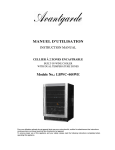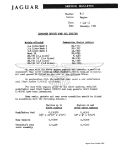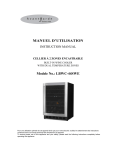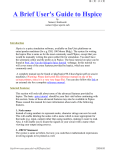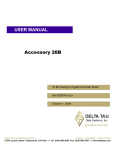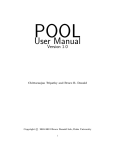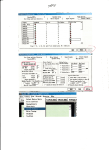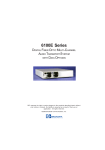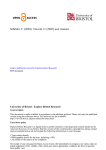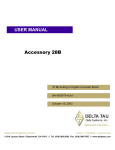Download ADAS205: Specific z excitation - process metastable and excited
Transcript
ADAS205: Specific z excitation - process metastable and excited state populations The program calculates excited state and metastable state populations of a selected ion in a plasma of specified temperatures and densities by drawing on fundamental energy level and rate coefficient data from a specific ion file of type ADF04. Background theory: +z + z +1 Consider ions X of the element X . The adjacent ionisation stages are X and X + z −1 . Let the levels of the ion X + z be separated into the metastable levels X ρ+ z , +z indexed by Greek indices, and excited levels X i , indexed by Roman indices. The collective name metastable states as used here includes the ground state. The driving +z mechanisms considered for populating the excited levels X i are excitation from the +z metastable levels X ρ and recombination from the ground level of the adjacent ion X 1+ z +1 . The dominant population densities of the ions in the plasma are those of the + z +1 +z + levels X ρ and X 1 , denoted by N ρ and N 1 respectively. They, or at least their ratios are assumed known from a dynamical ionisation balance. The other dominant population densities in the plasma are the electron density N e , the proton density N p and the neutral hydrogen density N H . The excited populations, denoted by N i , are assumed to be in a quasi-static equilibrium with respect to the dominant populations. The program evaluates the dependence of the excited populations on the dominant populations with this assumption. Let M denote the number of metastable levels and O denote the number of excited levels, hereafter called ordinary levels. The statistical balance equations take the form O M j =1 σ =1 ∑ Cij N j = − ∑ Ciσ N σ + N e N1+ ri + N e N H qi(CX ) i = 1, 2 ,.. 3.5.1 where the dominant populations (excluding the electron density) have been taken to the right hand side. The Cij and Ciσ are elements of the collisional-radiative matrix, ri is the free electron recombination coefficient directly to the level i and qi( CX ) is the charge exchange recombination coefficient from neutral hydrogen to the level i. The element Cij of the collisional-radiative matrix is composed as p) Cij = − Aj →i − N e q (je→) i − N pq (j → i≠ j 3.5.2 i (e) ( p) where A j →i , q j →i and q j →i are the rate coefficients for spontaneous transition, electron induced collisional transition and proton induced collisional transition respectively. Cii = ∑ Ai → j + N e ∑ qi(→e) j + N p ∑ qi(→p )j + N e qi( I ) j <i j ≠i j ≠i (I) the i is the total loss rate from level i, with q coefficient. The solution for the ordinary populations is ADAS User manual Chap3-05 3.5.3 electron impact ionisation rate 17 March 2003 O M O i =1 σ =1 i =1 N j = − ∑ C ji−1 ∑ Ciσ N σ + ∑ C −ji1ri N e N 1+ O + ∑ C −ji1qi( CX ) N H N 1+ 3.5.4 i =1 M ≡ ∑ Fj(σexc ) N e N σ + Fj(rec) N e N 1+ + Fj(CX ) N H N 1+ σ =1 ( exc ) ( rec) ( CX ) where the Fjσ , Fj and Fj are the effective contributions to the excited populations from excitation from the metastables, from free electron capture and from charge exchange recombination from neutral hydrogen respectively. All these coefficients depend on density as well as temperature. The actual population density of an ordinary level may be obtained from them when the dominant population densities are known. +z The full statistical equilibrium of all the level populations of the ion X , that is of metastables as well as ordinary levels relative to metastables, may also be obtained from the equations M O σ =1 j =1 ∑ Cρσ N σ = − ∑ Cρj N j + N e N1+rρ + N e N H qρ( CX ) 3.5.5 Substitution of the quasi-equilibrium solution for the ordinary levels, eqn. 3.5.4, gives M O O σ =1 j =1 i =1 O O j =1 i =1 ∑ ( Cρσ − ∑ Cρj ∑ C −ji1Ciσ ) N σ = N e N1+ (rρ + ∑ Cρj ∑ C ji−1ri ) O O j =1 i =1 + N H N 1+ (qρ(CX ) + ∑ Cρj ∑ C −ji1qi( CX ) ) 3.5.6 Solution of these equations gives an expression for the metastable populations N σ of the form 3.5.7 N σ ≡ Fσ( exc ) N 1 + Fσ( rec) N e N 1+ + Fσ(CX ) N H N 1+ The effective contributions to the metastable population densities (excluding the ground level) are expressed relative to the ground population density. Note also that + z +1 ion population density is not a full equilibrium with respect to the adjacent X + established. The ratio N 1 / N 1 may be specified arbitrarily in establishing actual population densities. The metastable to ground fractions in equilibrium if only ( exc ) . Substitution of eqn. 3.5.7 in eqn. 3.5.4 gives excitation is included are the Fσ the full statistical equilibrium population densities for the ordinary levels in terms of the ground population density and adjacent ion population density. M M N j = ∑ Fj(σexc ) Fσ( exc ) N e N 1 + ( Fj(rec) + ∑ Fj(σexc ) Fσ( rec) ) N e N1+ σ =1 σ =1 M + ( Fj( CX ) + ∑ Fj(σexc ) Fσ(CX ) ) N H N 1+ σ =1 3.5.8 + With densities N e , N p and the ratios N H / N e and N 1 / N 1 specified, the full equilibrium population densities relative to the ground level population density may be computed. Source data : The program operates on collections of fundamental rate coefficient data called specific ion files. The allowed content, organisation and formatting of these files is specified in ADAS data format ADF04. The scope of operation of ADAS205 is determined by the content of the specific ion file processed. The minimum content is the ion identification, ion, effective ion and nuclear charges, ionisation potential, an ADAS User manual Chap3-05 17 March 2003 indexed energy level and level assignment list, a set of temperatures and a set of level to level spontaneous transition probabilities and electron impact Maxwell averaged rate parameters at the specified temperatures. Data for upper to lower level only is required. Electron impact rate coefficients for both excitation and de-excitation are evaluated by interpolation at user selected values from the tabulated rate parameters in the specific ion file. Transition rate data is not required for all possible upper/lower level pairs, but the code checks that there are no 'untied' levels, that is without populating or depopulating processes. Strict energy ordering is not required in the specific ion file, the code re-orders as necessary. Proton induced rates, free electron recombination rates and charge exchange recombination rates may only be activated in the code if such data are present in the specific ion file. Transition data of these types are identified by a single letter code in the transition data line in the specific ion file. The code sorts the transition lines in the specific ion file into the allowed categories. Specific ion files can include additional data for the more complex excited state population calculations of code ADAS208. Such additional data, if present, are ignored by ADAS205. Centrally supported, specific ion data collections are archived in partitioned data sets. The status of these is described in the appendices. Note that ADAS205 can only make use of free electron recombination data from the ground level of the adjacent stage. Data from metastable levels of both higher and lower adjacent stages can be present in specific ion files but the code ADAS208 must be used to access them. ADAS205 allows inclusion of a simple ionisation rate (ECIP approximation) from excited levels, however a self consistent three-body recombination coefficient in detailed balance is not calculated or included. Nor is there any correction for higher excited levels not explicitly included in the specific ion file. These more complete aspects are handled by the advanced excited population code ADAS208. Extra information, which must be present in specific ion files ADF04 to allow these extensions are ignored by ADAS205. Program steps: These are summarised in fig. 3.5. Figure 3.5 5HDG DQG YHULI\ VSHFLILF LRQ ILOH UHSHDW 2XWSXW WDEOHV DQG JUDSKV HQG ! ! ! ! (QWHU XVHU GDWD DQG VHOHFWLRQV UHSHDW 'LVSOD\ SRSXODWLRQ JUDSKV &DOFXODWH SRSXODWLRQ GHQVLWLHV ! 6HOHFW VSHFLILF LRQ ILOH EHJLQ 6HOHFW WDEXODU DQG JUDSKLFDO RXWSXW RSWLRQV Interactive parameter comments: The file selection window has the appearance shown below 1. Data root a) shows the full pathway to the appropriate data subdirectories. Click the Central Data button to insert the default central ADAS pathway to the correct data type. The appropriate ADAS data format for input to this program is ADF04 (‘specific ion files’). Click the User Data button to insert the pathway to your own data. Note that your data must be held in a similar file structure to central ADAS, but with your identifier replacing the first adas, to use this facility. 2. The Data root can be edited directly. Click the Edit Path Name button first to permit editing. ADAS User manual Chap3-05 17 March 2003 3. 4. 5. 6. 7. Available sub-directories are shown in the large file display window b). Scroll bars appear if the number of entries exceed the file display window size. Click on a name to select it. The selected name appears in the smaller selection window c) above the file display window. Then its sub-directories in turn are displayed in the file display window. Ultimately the individual datafiles are presented for selection. Datafiles all have the termination .dat. Once a data file is selected, the set of buttons at the bottom of the main window become active. Clicking on the Browse Comments button displays any information stored with the selected datafile. It is important to use this facility to find out what is broadly available in the dataset. The possibility of browsing the comments appears in the subsequent main window also. Clicking the Done button moves you forward to the next window. Clicking the Cancel button takes you back to the previous window 2 1 3 4 5 7 6 The processing options window has the appearance shown below 1. 2. An arbitrary title may be given for the case being processed. For information the full pathway to the dataset being analysed is also shown. The button Browse comments again allows display of the information field section at the foot of the selected dataset, if it exists. There are three ‘pop-up’ windows for setting temperatures, densities and for designating metastable levels. For the temperature window, click on the Edit Table button to open up the table editor. The editing operations are as described in the Chap1-00. Note that there is a set of input electron temperatures from the selected file. These indicate the safe range of temperatures if extrapolation is to ADAS User manual Chap3-05 17 March 2003 3. 4. 5. 6. be avoided. Note that altering units (which must be done with the table edit window activated) converts the input values and interprets the output values in the selected units. It does not convert output values already typed in. Default Temperatures are inserted in the selected units on clicking the appropriate button. Note that the ion and neutral hydrogen temperatures are only used if such collisional data is present in the input ADF04 file. The densities table is handled in like manner. Note that in this case there are no input density values. Thus unit changing only affects the interpretation of the output values created by the user. The NH/Ne and N(z1)/N(z) are only used if neutral hydrogen charge exchange data and free electron recombination data are present in input ADF04 file. These ratio vectors are specified at each electron density so the ratio vectors and electron density vector are of the same length. That is, a model is specified. By contrast the output electron temperatures are independent so that final calculated populations are obtained at points of a twodimensional electron temperature/electron density grid. The Metastable State Selections button pops up a window indexing all the energy levels. Activate the buttons opposite levels which you wish treated as metastables. Various processes, supplementary to the primary electron excitation collisions and bound-bound radiative transitions, are activated as desired by clicking on the appropriate buttons. Note again these only have an effect if such data is present in the ADF04 file except for Ionisation rates. This activates ionisation out of excited states and is obtained by an internal calculation of these rates in the ECIP approximation. Warning-ionisation should not be switched on if you have included auto-ionising levels in your ADF04 dataset but have omitted the details of alternative thresholds etc present in advanced ADF04 files. Proton collisions may be present in the ADF04 file. If so, these rate coefficients may be scaled to represent a mixture of other charged projectiles with a mean Zeffective. 1 3 2 6 5 4 ADAS User manual Chap3-05 17 March 2003 The output graphic options window has the appearance shown below 1. 2. 3. 4. As in the previous window, the full pathway to the file being analysed is shown for information. Also the Browse comments button is available. Click on the Graphics or Text buttons to toggle between sub-windows for setting up the graphics output or the text file output. Graphical display is activated by the Graphical Output button. This will cause a graph to be displayed following completion of this window. When graphical display is active, an arbitrary title may be entered which appears on the top line of the displayed graph. By default, graph scaling is adjusted to match the required outputs. Press the Explicit Scaling button to allow explicit minima and maxima for the graph axes to be inserted. Activating this button makes the minimum and maximum boxes editable. 2 1 6 3 4 5 7 5. 6. 7. Hard copy is activated by the Enable Hard Copy button. The File name box then becomes editable. If the output graphic file already exits and the Replace button has not been activated, a ‘pop-up’ window issues a warning. Graphical output is at one selected temperature. Make this choice from the list. A choice of output graph plotting devices is given in the Device list window. Clicking on the required device selects it. It appears in the selection window above the Device list window. The output text options sub-window has the appearance shown below 1. ADAS User manual The Text Output button activates writing to a text output file. The file name may be entered in the editable File name box when Text Output is on. The default file name ‘paper.txt’ may be set by pressing the button Default file Chap3-05 17 March 2003 2. name. A ‘pop-up’ window issues a warning if the file already exists and the Replace button has not been activated. The Contour File button should be activated to write the passing file for use by the diagnostic line ratio program ADAS207. There is no arrangement for permanent storage of such files which reside only in a user’s file space and are generally prepared for temporary immediate use. Usually in ADAS such temporary ‘passed files’ reside in the pass/ directory. By default ADAS205 sends the contour file to /...../<uid>/adas/pass/contour.pass 1 2 3 3. The METPOP File button should be activated to write a passing file of metastable population fractions. It is of data format ADF11 and can be used in ionisation/recombination applications of ADAS4 series programs. It goes by default into /...../<uid>/adas/pass/metpop.pass The Graphical output window is shown below 1. The graph has at its foot a Done button, and possibly Next and Previous buttons if there is a sequence of graphs to be displayed. A Print and Print all button is also present if the Enable Hard Copy button on the previous window was activated. 2. Press the Next button to show the next graph in a sequence and the Previous button to show the previous graph. 3. Press the Print button to make a hard copy of the currently displayed picture. Print all makes a hard copy of all the pictures. 4. Pressing the Done button restores the previous Output Options window. ADAS User manual Chap3-05 17 March 2003 1 2 3 4 Illustration: The output from the program is shown for the lithium-like ion O+5. The specific ion file is assembled from the data of Sampson and co-workers. Figure 3.5a ADAS User manual Chap3-05 17 March 2003 The tabular output is shown in table 3.5. Table 3.5 ADAS RELEASE: ADAS98 V2.1 PROGRAM: ADAS205 V1.8 DATE: 10/03/99 TIME: 16:44 *********** TABULAR OUTPUT FROM METASTABLE POPULATION PROGRAM: ADAS205 - DATE: 10/03/99 *************** INPUT COPASE FILE NAME: /packages/adas/adas/adf04/copsm#li/copsm#li_sm#o5.dat ION NUCLEAR RECOMBINING ------- IONIZATION POTENTIAL ------CHARGE (Z0) ION CHARGE (Z1) (wave number <cm-1>) (rydbergs) -----------------------------------------------------------------------------O + 5 8 6 1114008. 10.1516096 ----------------------------------------- ENERGY LEVELS ------------------------------------------------INDEX CONFIGURATION (2S+1)L(J) -- ENERGY RELATIVE TO LEVEL 1 -- ENERGY RELATIVE TO IONISATION POTENTIAL (wave number <cm-1>) (rydbergs) (wave number <cm-1>) (rydbergs) -------------------------------------------------------------------------------------------------------1 2s1 (2)0( 0.5) 0. 0.0000000 1114008. 10.1516096 2 2p1 (2)1( 0.5) 96376. 0.8782492 1017632. 9.2733604 . . . 23 5g1 (2)4( 3.5) 956672. 8.7178535 157336. 1.4337560 24 5g1 (2)4( 4.5) 956674. 8.7178736 157334. 1.4337360 -- INPUT COPASE FILE TEMPERATURES: (TE=TP=TH) -INDEX (kelvin) (eV) (reduced) -----------------------------------------------1 1.80D+04 1.55D+00 5.00D+02 2 3.60D+04 3.10D+00 1.00D+03 3 7.20D+04 6.20D+00 2.00D+03 4 1.80D+05 1.55D+01 5.00D+03 5 3.60D+05 3.10D+01 1.00D+04 ADAS User manual Chap3-05 17 March 2003 7 8 9 6 10 11 1.80D+06 3.60D+06 7.20D+06 7.20D+05 1.80D+07 3.60D+07 1.55D+02 3.10D+02 6.20D+02 6.20D+01 1.55D+03 3.10D+03 5.00D+04 1.00D+05 2.00D+05 2.00D+04 5.00D+05 1.00D+06 INPUT COPASE FILE INFORMATION: -----------------------------NUMBER OF ELECTRON IMPACT TRANSITIONS NUMBER OF PROTON IMPACT TRANSITIONS NUMBER OF CHARGE EXCHANGE RECOMBINATIONS NUMBER OF FREE ELECTRON RECOMBINATIONS METASTABLE INFORMATION: ----------------------NUMBER OF ORDINARY LEVELS NUMBER OF METASTABLES = = = = = = 132 0 0 0 23 1 ---------------- METASTABLE DETAILS ---------------METASTABLE ENERGY LEVEL ---- DESIGNATION ----INDEX INDEX ---------------------------------------------------1 1 2s1 (2)S( 0.5) OUTPUT PLASMA PARAMETERS: ------------------------NUMBER OF TEMPERATURES = 10 NUMBER OF DENSITIES/RATIOS = 6 INDEX ---- TEMPERATURES (UNITS: eV) ---------ELECTRON PROTON NEUTRAL HYDROGEN N(Z+1)/N(Z) <TE> <TP> <TH> ------------------------------------------------------1 1.551D+00 * 1.551D+00 # 1.551D+00 # 0.000D+00 # 2 3.102D+00 3.102D+00 # 3.102D+00 # 0.000D+00 # 3 6.204D+00 6.204D+00 # 6.204D+00 # 0.000D+00 4 2.000D+01 2.000D+01 # 2.000D+01 # 0.000D+00 # 5 3.102D+01 3.102D+01 # 3.102D+01 # 0.000D+00 # 6 6.204D+01 6.204D+01 # 6.204D+01 # 0.000D+00 # 7 1.551D+02 1.551D+02 # 1.551D+02 # 8 3.102D+02 3.102D+02 # 3.102D+02 # 9 6.204D+02 6.204D+02 # 6.204D+02 # 10 1.551D+03 1.551D+03 # 1.551D+03 # ------------------------------------------------------KEY: * = WARNING - TEMPERATURE OUT OF RANGE ELECTRON DENSITY - EXTRAPOLATION REQUIRED # = PARAMETER NOT USED IN CALCULATIONS ------------------------------------------------------PROTON IMPACT COLLISIONS - NOT INCLUDED IONIZATION RATES - NOT INCLUDED NEUTRAL HYDROGEN CHARGE EXCHANGE - NOT INCLUDED FREE ELECTRON RECOMBINATION - NOT INCLUDED INDEX DENSITIES (UNITS: cm-3) ELECTRON PROTON ----- RATIOS NH/NE <NE> <NP> -----------------------------------------------1 1.000D+12 0.000D+00 # 0.000D+00 # 2 1.000D+13 0.000D+00 # 0.000D+00 # 3 1.000D+14 0.000D+00 # 0.000D+00 # 4 1.000D+15 0.000D+00 # 0.000D+00 # 5 1.000D+16 0.000D+00 # 0.000D+00 # 6 1.000D+17 0.000D+00 # 0.000D+00 # -----------------------------------------------NOTE: NH/NE = NEUTRAL HYDROGEN DENSITY / N(Z+1)/N(Z) = STAGE ABUNDANCIES ------------------------------------------------ TABLE KEY: ---------NE = ELECTRON DENSITY TE = ELECTRON TEMPERATURE I = ENERGY LEVEL INDEX IMET = METASTABLE INDEX IORD = ORDINARY LEVEL INDEX NUMBER OF PROTON IMPACT COLLISIONS INCLUDED = NUMBER OF FREE ELECTRON RECOMBINATIONS INCLUDED = NUMBER OF CHARGE EXCHANGE RECOMBINATIONS INCLUDED = 0 0 0 NE(CM-3)= 1.0000E+12 1.0000E+13 1.0000E+14 1.0000E+15 1.0000E+16 1.0000E+17 -------------------------------------------------------------------------------------------------EQUILIBRIUM METASTABLE POPULATION DEPENDENCE ON DENSITY AT TE = 1.55E+00 EV = 1.80E+04 KELVIN IMET I 1 1 1.0000E+00 1.0000E+00 1.0000E+00 1.0000E+00 1.0000E+00 1.0000E+00 ADAS User manual Chap3-05 17 March 2003 POPULATION DEPENDENCE ON DENSITY AND METASTABLE IORD I 1 2 6.2366E-08 6.2286E-07 6.1504E-06 2 3 1.1725E-07 1.1711E-06 1.1572E-05 3 4 2.2911E-29 2.2918E-28 2.2978E-27 4 5 2.2305E-31 2.2667E-30 2.6227E-29 5 6 4.3778E-31 4.4483E-30 5.1439E-29 6 7 1.7310E-31 1.7473E-30 1.9082E-29 7 8 2.5794E-31 2.6037E-30 2.8431E-29 8 9 2.8873E-37 2.8859E-36 2.8729E-35 9 10 1.6382E-38 1.6622E-37 1.8966E-36 10 11 3.2484E-38 3.2958E-37 3.7583E-36 11 12 1.7811E-38 1.7975E-37 1.9591E-36 12 13 2.6648E-38 2.6892E-37 2.9306E-36 13 14 1.3370E-38 1.3441E-37 1.4154E-36 14 15 1.7847E-38 1.7941E-37 1.8887E-36 15 16 8.3707E-41 8.3244E-40 7.9154E-39 16 17 8.8226E-42 9.0143E-41 1.0730E-39 17 18 1.7513E-41 1.7895E-40 2.1309E-39 18 19 1.1278E-41 1.1384E-40 1.2454E-39 19 20 1.6963E-41 1.7120E-40 1.8702E-39 20 21 1.3626E-41 1.3705E-40 1.4529E-39 21 22 1.8165E-41 1.8271E-40 1.9369E-39 22 23 2.0837E-42 2.0961E-41 2.2256E-40 23 24 2.6022E-42 2.6180E-41 2.7786E-40 1 5.4679E-05 1.0338E-04 2.3507E-26 5.7389E-28 1.1252E-27 3.3295E-28 4.9646E-28 2.7912E-34 3.7877E-35 7.4992E-35 3.3905E-35 5.0721E-35 2.1696E-35 2.8917E-35 6.2136E-38 1.9522E-38 3.8786E-38 2.2037E-38 3.2931E-38 2.4483E-38 3.2608E-38 3.6483E-39 4.5451E-39 2.6104E-04 4.9845E-04 2.5598E-25 1.8484E-26 3.6398E-26 9.6527E-27 1.4466E-26 2.8150E-33 9.2182E-34 1.8305E-33 9.6000E-34 1.4391E-33 8.7409E-34 1.1668E-33 6.5600E-37 3.9242E-37 7.8131E-37 6.0693E-37 9.0800E-37 8.2128E-37 1.0936E-36 2.9210E-37 3.6518E-37 4.2048E-04 8.0555E-04 2.4476E-24 2.4921E-25 4.9102E-25 1.6637E-25 2.4945E-25 3.1728E-32 1.2893E-32 2.5637E-32 1.7874E-32 2.6793E-32 2.3864E-32 3.1832E-32 1.0332E-35 6.6905E-36 1.3340E-35 1.1335E-35 1.6988E-35 1.6339E-35 2.1777E-35 2.0712E-35 2.5913E-35 . . . ********************************* EQUILIBRIUM POPULATIONS *********************************** LEVEL = 1 - EQUILIBRIUM POPULATION ----------------------------------NE (CM-3) 1.00D+12 1.00D+13 1.00D+14 1.00D+15 1.00D+16 1.00D+17 TE (EV) ----------------------------------------------------------------------------------1.55D+00 | 1.00D+00 1.00D+00 1.00D+00 1.00D+00 1.00D+00 1.00D+00 3.10D+00 | 1.00D+00 1.00D+00 1.00D+00 1.00D+00 1.00D+00 1.00D+00 6.20D+00 | 1.00D+00 1.00D+00 1.00D+00 1.00D+00 1.00D+00 1.00D+00 2.00D+01 | 1.00D+00 1.00D+00 1.00D+00 1.00D+00 1.00D+00 1.00D+00 3.10D+01 | 1.00D+00 1.00D+00 1.00D+00 1.00D+00 1.00D+00 1.00D+00 6.20D+01 | 1.00D+00 1.00D+00 1.00D+00 1.00D+00 1.00D+00 1.00D+00 1.55D+02 | 1.00D+00 1.00D+00 1.00D+00 1.00D+00 1.00D+00 1.00D+00 3.10D+02 | 1.00D+00 1.00D+00 1.00D+00 1.00D+00 1.00D+00 1.00D+00 6.20D+02 | 1.00D+00 1.00D+00 1.00D+00 1.00D+00 1.00D+00 1.00D+00 1.55D+03 | 1.00D+00 1.00D+00 1.00D+00 1.00D+00 1.00D+00 1.00D+00 . . . LEVEL = 24 - EQUILIBRIUM POPULATION ----------------------------------NE (CM-3) 1.00D+12 1.00D+13 1.00D+14 1.00D+15 1.00D+16 1.00D+17 TE (EV) -----------------------------------------------------------------------------------1.55D+00 | 2.60D-42 2.62D-41 2.78D-40 4.55D-39 3.65D-37 2.59D-35 3.10D+00 | 7.32D-26 7.35D-25 7.68D-24 1.12D-22 7.32D-21 5.95D-19 6.20D+00 | 1.00D-17 1.01D-16 1.04D-15 1.40D-14 7.47D-13 7.01D-11 2.00D+01 | 2.56D-12 2.57D-11 2.62D-10 3.24D-09 1.37D-07 1.63D-05 3.10D+01 | 1.54D-11 1.55D-10 1.58D-09 1.92D-08 7.72D-07 1.01D-04 6.20D+01 | 6.31D-11 6.32D-10 6.44D-09 7.73D-08 3.00D-06 4.48D-04 1.55D+02 | 1.03D-10 1.03D-09 1.05D-08 1.26D-07 4.81D-06 8.61D-04 3.10D+02 | 9.05D-11 9.07D-10 9.24D-09 1.11D-07 4.22D-06 8.75D-04 6.20D+02 | 6.98D-11 6.99D-10 7.12D-09 8.50D-08 3.13D-06 7.34D-04 1.55D+03 | 4.03D-11 4.04D-10 4.11D-09 4.88D-08 1.69D-06 4.62D-04 Notes: ADAS User manual Chap3-05 17 March 2003











